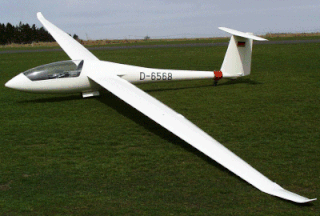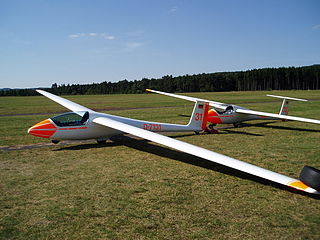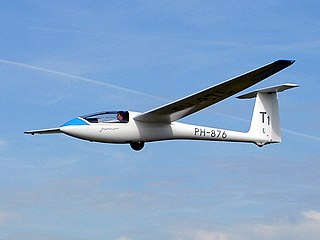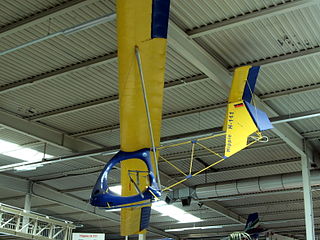
The Schempp-Hirth Ventus is a sailplane produced during 1980–1994 by Schempp-Hirth, a German sailplane manufacturer. It was designed by Klaus Holighaus and replaced the Schempp-Hirth Mini-Nimbus. Schempp-Hirth manufactured 613 Ventus sailplanes.

The Rolladen-Schneider LS7 is a high-performance Standard Class single-seat sailplane produced by Rolladen-Schneider Flugzeugbau GmbH from 1988 to 1993.

The Rolladen-Schneider LS4 is a Standard Class single seat glider manufactured by Rolladen-Schneider Flugzeugbau GmbH between 1980 and 2003.

The Schempp-Hirth Mini Nimbus is a 15 Metre-class glider designed and built by Schempp-Hirth GmbH in the late 1970s.

The Schempp-Hirth Nimbus-2 is an Open Class glider built by Schempp-Hirth during the 1970s. The Nimbus-2 first flew in April 1971 and a total of over 240 examples of all subtypes have been built until the beginning of the 1980s. It replaced the Schempp-Hirth Cirrus.

The G102 Astir is a single seat glassfibre Club Class sailplane, designed by Burkhart Grob and built by Grob Aircraft. It was the first Grob-designed sailplane, with the first flight in December 1974. Grob had previously built the Schempp-Hirth Standard Cirrus under licence.

The G103 Twin II is a high-performance two-seat sailplane manufactured in Germany by Grob Aircraft. The aircraft is of T-tail configuration, and is fitted with upper-surface airbrakes and a non-retractable undercarriage. Of fiberglass construction, it is designed for training, high performance cross-country racing and simple aerobatic flying.

The Schleicher ASK 18 is a single-seat sailplane that was built by the German manufacturer Alexander Schleicher GmbH & Co. It was designed to be a sturdy aircraft for inexperienced solo pilots and so uses a simple and rugged construction and has docile handling characteristics.

The Schleicher ASK 23 is a single-seat Club Class sailplane that was built by the German manufacturer Alexander Schleicher GmbH & Co.

The Glasflügel 206 Hornet is a Standard Class sailplane produced in Germany between 1975 and 1979. Of conventional sailplane design with a T-tail, it replaced the Standard Libelle, featuring composite construction throughout. Differences from the earlier aircraft included a redesigned canopy, retractable monowheel landing gear, and provision for 100 kg (220 lbs) of water ballast.

The Grob G 103 Twin Astir is a glass-reinforced plastic two-seat sailplane that was developed in Germany in the 1970s by Grob Aircraft AG as a counterpart to the single-seat G 102 Astir then in production. Construction throughout is similar, although to preserve the centre of gravity of the design, the wings were given a slight forward sweep. While many two-seat derivatives of single-seat sailplanes have fixed undercarriage, due to the added space restrictions created by the second seat, Grob devised a novel retraction system for the Twin Astir. The single wheel was designed to rotate 90° sideways before retracting "flat" under the rear seat, resulting in a rather unusual seating position. This was only incorporated in early examples, later on, the wheel was fixed. Factory options offered to customers included whether the front seat should be equipped with flight instruments, and whether water ballast capacity should be installed.
The Torva 15 was a single-seat glider designed and built in United Kingdom from 1970.
The SZD-40x Halny is an experimental two-seat glider designed and built in Poland in 1971.
The Applebay Zuni and Zuni II are single-seat, water-ballasted gliders designed to compete in the FAI 15m class.

The Glasflügel 205 Club Libelle is a high wing, T-tailed, single seat glider that was designed and produced in West Germany by Glasflügel for club and rental use.

The PZL Bielsko SZD-51 Junior is a Polish single-seat training and club sailplane.
The Akaflieg Darmstadt D-40 is an experimental variable geometry single seat sailplane, fitted with almost full span, camber changing flaps for optimum aerodynamics in weak thermals and integrated into the wing so as to minimise flap tip drag. One flew successfully but the D-40, like other variable geometry sailplanes, was not commercialised.
The Akaflieg Braunschweig SB-12 is a single seat, Standard Class sailplane designed around 1980 by German technical university students to test out a new wing profile from the German Aerospace Centre. It was not intended for production, but the sole SB-12 remains active in 2010.

The Start + Flug H-111 Hippie, later retailed as the Hänle Hippie is a basic single seat glider, its weight kept low with the use of modern composite materials. It can be foot launched or by other methods. It was designed and built in Germany in the 1970s.
The LAK-15, sometimes known as the LAK-15 Lietuve, was a high performance sailplane designed to set records. A one-off, it was built in the late 1980s in Lithuania, then a member of the USSR.














